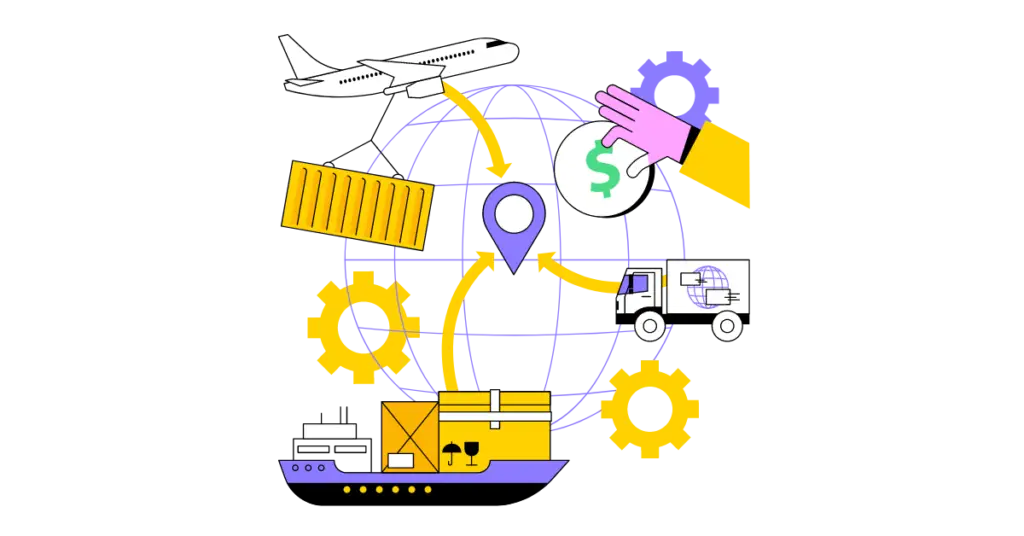Understanding the full cost of acquiring products is crucial for businesses, especially those involved in importing goods. This total expense, known as landed cost, encompasses not just the purchase price but also all associated costs from the supplier to the final destination. Landed costs include shipping, customs duties, insurance, handling fees, and other charges that contribute to the final price of a product. Accurately calculating landed costs is essential for setting competitive prices, managing margins, and optimizing supply chain operations. In this blog, we’ll delve into what landed cost is, why it’s important, the factors that contribute to it, and how to calculate it effectively. We’ll be discussing:
- What is Landed Cost?
- Why is Landed Cost Important?
- Factors of Landed Cost
- How to Calculate Landed Cost
- Example of Landed Cost Calculation
What is Landed Cost?

Landed cost refers to the total expense a business incurs to get a product from the supplier to its final destination. This includes the purchase price and all related costs, such as shipping, customs duties, insurance, handling fees, and other charges. Essentially, landed cost is the true total cost of acquiring a product, reflecting all expenses associated with bringing it to your warehouse or store.
Understanding landed cost is crucial for businesses that import goods or operate in industries where transportation and handling costs significantly impact overall profitability. Knowing the landed cost helps businesses set appropriate prices, manage margins, and avoid unexpected expenses that could erode profits.
Why is Landed Cost Important?
Landed cost is a key metric for businesses involved in importing goods or managing complex supply chains. It’s not just about knowing how much you’re paying for a product but understanding the total financial commitment required to get that product to where it needs to be.
- Accurate Pricing: Landed cost allows businesses to set accurate and competitive prices. By considering all costs involved in acquiring a product, businesses can ensure their pricing strategy covers these expenses and still provides a healthy margin.
- Profitability: By calculating the landed cost, businesses can better understand their profit margins. Without knowing the landed cost, it’s easy to underestimate expenses, leading to reduced profitability or even losses.
- Inventory Management: Understanding landed costs can also aid in inventory management. It allows businesses to assess whether the costs of holding and moving inventory are justified, leading to more informed decisions about inventory levels and purchasing strategies.
- Supply Chain Optimization: Knowing the landed cost helps businesses identify inefficiencies in their supply chain. For instance, if shipping costs are disproportionately high, it might make sense to explore alternative suppliers or shipping methods.
- Budgeting and Forecasting: With a clear understanding of landed costs, businesses can create more accurate budgets and forecasts, helping to ensure financial stability and growth.
Factors of Landed Cost

Several factors contribute to the calculation of landed cost. Each of these factors can vary depending on the product, supplier, and shipping method.
- Purchase Price: This is the base price of the product itself. It’s the starting point for calculating the landed cost.
- Shipping Costs: This includes all expenses related to transporting the product from the supplier to your location. It can include freight charges, fuel surcharges, and any additional fees levied by the shipping company.
- Customs Duties and Taxes: Customs duties, tariffs, and taxes can significantly impact landed costs when importing goods. These charges are often based on the product’s value, weight, or classification and vary depending on the country of origin and destination.
- Insurance: Insurance costs protect the shipment during transit by covering any potential loss or damage to the goods. These costs often factor into the landed cost.
- Handling and Logistics Fees: These costs cover the management of the product as it moves through the supply chain. This can include warehousing fees, loading and unloading charges, and any other handling costs.
- Currency Conversion: If you’re purchasing goods in a foreign currency, fluctuations in exchange rates can affect the landed cost. It’s essential to consider the impact of currency conversion when calculating landed costs.
- Brokerage Fees: If you use a customs broker to handle the import process, their fees will also be part of the landed cost. This can include paperwork processing, communication with customs officials, and other administrative tasks.
How to Calculate Landed Cost
Calculating the landed cost involves adding up all the factors mentioned above to arrive at the total expense incurred to acquire a product. Here’s a step-by-step guide to calculating landed cost:
- Determine the Purchase Price: Start with the base price of the product as charged by the supplier.
- Add Shipping Costs: Include all freight charges, fuel surcharges, and any additional shipping fees.
- Include Customs Duties and Taxes: Calculate the customs duties, tariffs, and taxes based on the product’s value, weight, or classification.
- Factor in Insurance Costs: Add the cost of insuring the shipment during transit.
- Account for Handling and Logistics Fees: Include any warehousing, loading, unloading, and other logistics-related expenses.
- Adjust for Currency Conversion: If applicable, convert the purchase price and other costs into your local currency, factoring in the exchange rate.
- Add Brokerage Fees: If you use a customs broker, include their fees in the total.
- Sum All Costs: Add up all the costs to arrive at the total landed cost.
Example of Landed Cost Calculation

Let’s say you’re importing 100 units of a product from a supplier overseas. Here’s how you would calculate the landed cost:
- Purchase Price: $10,000 (for 100 units)
- Shipping Costs: $1,500
- Customs Duties and Taxes: $800
- Insurance: $200
- Handling and Logistics Fees: $300
- Currency Conversion: Assume no impact (same currency)
- Brokerage Fees: $100
Total Landed Cost = $10,000 + $1,500 + $800 + $200 + $300 + $100 = $12,900
So, the landed cost per unit is $12,900 / 100 = $129 per unit.
This means each unit costs $129 to get from the supplier to your warehouse, which is the amount you would need to cover in your pricing strategy to ensure profitability.
Conclusion
Understanding what landed cost is and how to calculate it is essential for businesses that deal with importing goods or managing complex supply chains. By considering all the factors that contribute to landed cost—such as purchase price, shipping costs, customs duties, insurance, and handling fees—businesses can ensure they have an accurate picture of the total cost of acquiring a product. This allows for better pricing strategies, improved profitability, and more effective supply chain management.
Whether you’re a small business owner or a supply chain manager, mastering the concept of landed cost is crucial for financial success. It’s not just about knowing what you’re paying for a product; it’s about understanding the full financial impact of getting that product to your door. By doing so, you can make informed decisions that drive profitability and growth, ensuring your business remains competitive in the global marketplace.
Related Content






